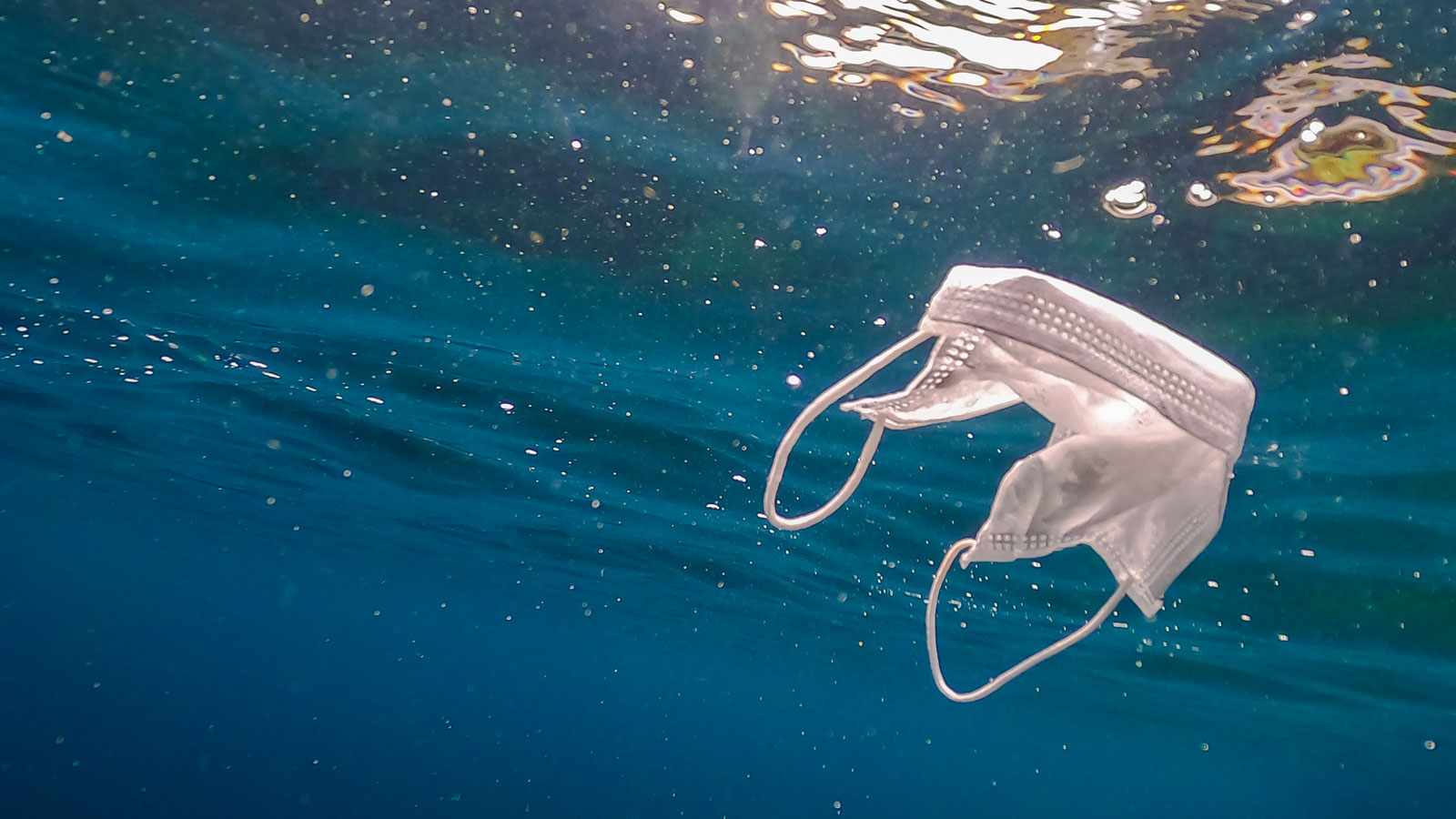W. Aaron Vandiver is a writer, attorney, and wildlife conservationist. He is the author of the novel Under a Poacher’s Moon, released on February 1, 2022.
An estimated 1.6 billion disposable masks made their way into the oceans in 2020 — that’s more than 4 million per day. By the end of 2021, the world had generated about 8 million tons of COVID-related plastic waste, much of it surgical and N95 masks, with some 26,000 tons ending up in the sea.
I live in the Colorado Rockies, where we live and breathe environmentalism. I hear the occasional grumble about the profusion of plastic takeout containers and, more recently, the excessive packaging of home COVID tests. But I sometimes wonder if I’m the only one thinking about the plastic litter that masks create. I recently mentioned this to an environmentally minded acquaintance who responded in surprise, “They’re made out of plastic?!”
This seems true of many green organizations as well: Most aren’t grappling with the reality that yes, most masks are plastic, or they are reticent to speak too loudly about the problem.
During the first year of the pandemic, health experts and green groups told us to stick to reusable cloth coverings (or to make our own from an old T-shirt). As the more contagious omicron variant surged, few have spoken up about the environmental impacts of “upgrading” to N95 masks. It may be understandable that the planet has taken a backseat to immediate concerns for human health and safety. And it hasn’t helped that mask debates have become so contentious. But now that state and local governments are dropping mandates as omicron cases decline, we need to start a conversation about mask pollution.
[Read: We need a global leader on plastics. Could it be Biden?]
An unfortunate but unavoidable fact is that surgical and N95 masks (and personal protective equipment and testing kits) are single-use plastics or, at best, double- or triple-use plastics. Surgical and most respirator masks are made from polypropylene, a synthetic plastic fiber which, like all plastics, is generated from petroleum. While they can and often are used more than once, experts don’t recommend wearing them for more than two or three days.
So the 400 million N95 masks that the Biden administration recently began making available to Americans, and the millions of “high quality” masks it is distributing to kids, will get a few days of use at most before going in the trash. From there, many will end up in landfills, where they leach toxic chemicals into groundwater, or be incinerated, releasing carbon dioxide and toxic chemicals. Many others will eventually wind up in rivers and oceans, and make their way into the gullets of sea birds like the Laysan albatross, who mistakenly feed on plastic and give it to their chicks. This compounds an already alarming problem, as some 90 percent of seabirds are believed to have ingested plastic in some form already. The insidious material will also be eaten by whales, some of which have bellies filled with plastic waste. By some estimates, plastic in the world’s oceans could outweigh fish by 2050, a problem masks will only exacerbate.
By some estimates, plastic in the world’s oceans could outweigh fish by 2050, a problem masks will only exacerbate.
Masks in the ocean can take as long as 450 years to break down, creating ever-smaller pieces of plastic in the process, according to the marine conservation organization OceansAsia. These microplastics are increasingly impacting oceanic microorganisms and accumulating in the food chain; one 2018 study found that 100 percent of sea turtles examined had microplastics in their digestive system.
Another thing to consider: Like all single-use plastics, masks boost greenhouse gas emissions at every point in their life cycle.
Environmental groups have long recognized that limiting plastic throwaways is the only effective means of reducing their impact. This is why some states and cities have banned plastic bags and straws, and former President Obama signed the Microbead-Free Waters Act of 2015 banning microplastics in cosmetics.
Masks cannot be banned like other single-use plastics, of course, but we need to recognize that they have the same devastating impact. For the sake of the planet, we must factor this into our personal decisions whether to wear one, and policymakers must consider this as well as they weigh the benefits and drawbacks of mask mandates. Environmentalists may be reluctant to participate in these controversies, but we should look for ways to use fewer plastic masks without undermining their legitimate and necessary uses.
It might be tempting to think that we can recycle masks, or that there is some other easy fix, but managing the waste generated by plastic products is an incredibly complex global problem with “no single solution,” according to a 2020 study by the Pew Charitable Trusts. Even before COVID, Pew expected plastic pollution flowing into the oceans to triple by 2040, absent major regulatory and economic reforms worldwide. Recycling does not keep single-use plastics out of the oceans, or out of landfills and incinerators, and an estimated 91 percent of goods made with the stuff are not recycled at all.
Researchers at Cornell University recently came up with a plan to shred masks and other PPE, then heat those smaller bits to break them down into useful chemicals like ethylene, propylene, propane, and butane. To meaningfully reduce plastic waste, this method would need to be implemented by states and countries on a large scale, but this kind of “chemical recycling” has been criticized for causing carbon emissions and releasing toxic chemicals into the atmosphere. It’s also costly.
What about reusable N95s? A team at MIT has studied possible ways to decontaminate and reuse N95 masks, potentially by making them from silicone, but so far we have not seen such technologies implemented at scale, and it’s not clear if they are practical solutions.
The fact remains that the “single use plastic mask is just another additional burden that we are leaving behind for the future generations,” as Gary Stokes, the cofounder of OceansAsia, has said.
While a number of states have recently announced plans to end or draw down mask mandates, what happens when the next variant arises?
Those of us who care about the state of the planet need to help forge a more sustainable long-term approach. Government officials and public health experts will continue debating recommendations, but environmentalists can and should advocate for the planet. Although N95s have a large footprint, the good news is that they can provide one-way protection, which means that wearers can shield themselves even when others around them are unmasked. A more limited, judicious approach to the use of surgical and N95 masks — encouraging use in clinical settings and to protect people who are vulnerable to COVID-19 while discouraging overuse among healthy, asymptomatic people — may sensibly balance public health priorities with environmental concerns, and potentially prevent vast numbers of plastics from polluting the world. Short of major technological breakthroughs, using fewer plastic masks is the best we can do.
Now that cases are declining and mandates and emergency measures are winding down (at least for now), we are left with difficult questions: Under what circumstances is it justified to wear, or require others to wear, masks that are harmful to the planet? How much damage will be done to oceans, marine life, and the climate, if millions or billions of people continue wearing them on a regular basis? How much damage have we done already? What will it take to minimize the damage in the future?
However you feel about masking, we all will have to reckon with the environmental legacy for years to come. The sooner that conversation starts, the better.
The views expressed here reflect those of the author.
Fix is committed to publishing a diversity of voices, and we want to hear from you. Got a bold idea, fresh perspective, or insightful news analysis? Send a draft, along with a note about who you are, to opinions@grist.org.



